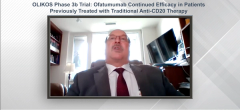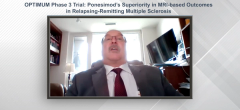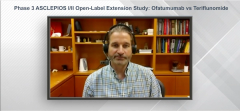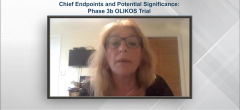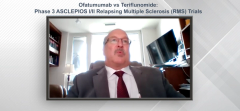
Takeaways From ACTRIMS-ECTRIMS 2020 Meeting
Episodes in this series

Dr Mark Freedman shares exciting takeaways from the 8th Joint ACTRIMS-ECTRIMS meeting, including the utility of serum biomarkers of disease activity.
Mark Freedman, MD, MSc: I’ve been asked to comment on some highlights from the 8th joint meeting of ACTRIMS [Americas Committee for Treatment and Research in Multiple Sclerosis] and ECTRIMS [European Committee for Treatment and Research in Multiple Sclerosis], which was held for the first time virtually in September in 2 parts. The entire meeting was a few weeks ago, and then this past weekend, they held late-breaking sessions where we saw some interesting data being presented. I can’t say that there is a top message. There has been so much presented over those several days, but in terms of new clinical trials, one of the most important standouts was a surprise phase 3 trial looking at masitinib, which is a unique tyrosine kinase inhibitor focused in on mast cells as part of the innate immune system. It looked primarily at nonactive progressive forms of multiple sclerosis [MS]. Those would be primary progressive MS and secondary progressive MS cases that do not have any relapses or MRI activity in recent times. You would think this would be the hardest group in which to show a difference.
They looked at 2 different doses of masitinib and showed that the low dose actually did slow disease progression substantially, compared with placebo, in this nonactive group of patients, both in PP [primary progressive] and SP [secondary progressive] disease. Although the higher dosage did not have a significant effect, it looks like it may have been because placebo patients didn’t get worse. They set this up a bit strangely because the 4.5 mg and 6 mg doses were actually separate studies. They had their own placebo groups in each. In the future, what would look like the placebo group from 1 that did progress perhaps needs to look at the 6 mg dose. The drug was also poorly tolerated. There were a lot of GI [gastrointestinal] and skin adverse effects with the higher dose, so this is a drug that’s going to move forward into a new study looking at 4.5 mg/kg per day, since it has cracked the ice in this progressive group of patients for whom we lack good therapies. That was a really important takeaway.
Another takeaway from this meeting is the promotion of this notion of serum biomarkers being able to get a hint at what’s going on in this disease process without having to do MRIs or examine patients. We have a marker of disease activity. One of them is serum neurofilament light [NfL], and there were numerous presentations corroborating what has already been observed. It can predict which patients are going to get worse. It can predict relapse. It can predict MRI activity. As I remember, one study showed patients who were monitored regularly for their levels in the large Swiss registry. When the levels shot up, these were patients who were very likely to have continued activity. You could do these measurements in patients who are on a therapy thinking that they’re doing well, but if this number shoots up, you can say, “Maybe we should consider a change in therapy before something bad happens.” This is where that type of marker is going.
What do you do in patients who have progressive disease and don’t have much activity? That’s where the neurofilament light falls off, because it’s really driven by the active loss of axons. In the more progressive forms of MS, you don’t have this inflammatory activity anymore. Not surprisingly, the predictability of neurofilament light falls short, but a new marker, which is the serum GFAP [glial fibrillary acidic protein], has also been looked at by the Swiss. They showed that, especially in these nonactive forms of progressive MS, GFAP might be a marker that these patients are getting worse.
What it really gives us is the opportunity to now look at NfL and GFAP together to get a hint at activity and disease progression. Both of those are now giving us some insights on the disease, whereas before, we had to wait until things happened before we knew. It’s possible now that we have therapies that are potentially targeting progressive MS to slow disease progression. The hardest thing to understand is that if you gave someone one of these therapies that slow disease progression, but they progressed anyway as they did in the clinical studies—they just progressed slower than their placebo counterparts—patients don’t have placebo counterparts to measure themselves against. How do we know we’re winning this battle? How do we know we’re slowing disease progression faster than what would have happened in nature? One of these markers might be an indicator that the treatment is working, that even though the patients have progressed a bit, we’ve managed to lower those markers. That would give us an indication of a treatment effect. That was a very important evolution.
Newsletter
Keep your finger on the pulse of neurology—subscribe to NeurologyLive for expert interviews, new data, and breakthrough treatment updates.

